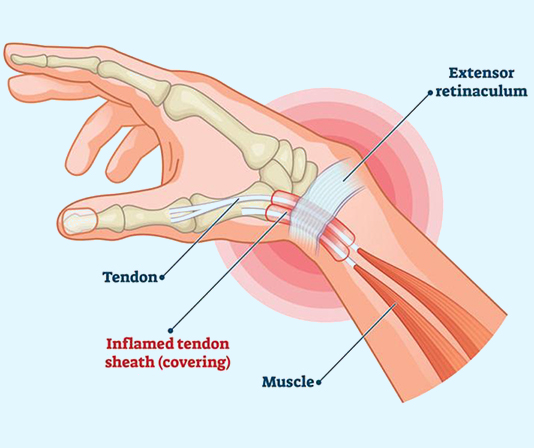De Quervain’s Tenosynovitis
What is it?
De Quervain’s Tenosynovitis is a condition of painful swelling and tenderness in the tendons along the thumb side of the wrist. This condition is caused by a thickening of the sheath, a tunnel-like structure that the tendons in the thumb travel through. These painful symptoms occur when the sheath becomes larger or more swollen and the tendons have less room to travel, therefore creating friction during wrist movement. The friction caused by the rubbing of these tendons creates inflammation which elicit pain.

De Quervain’s Tenosynovitis
What are the symptoms?
The primary symptom of de Quervain’s tenosynovitis is pain that occurs from the base of your thumb and can travel down to your forearm. The pain may come and go, however it is more likely to occur, worsen, or spread when you use your hand and wrist. Other symptoms can include stiffness, numbness, swelling, or a “snapping” motion in your thumb.
What is the cause?
The most common cause of this condition is overusing your thumb and/or wrist. For instance, playing certain sports or instruments that require the performance of repetitive hand motions can irritate the tendons over time. In addition, people with inflammatory arthritis or a previous injury to the wrist are more likely to develop de Quervain’s tenosynovitis.
How is it treated?
De Quervain’s tenosynovitis is usually treated conservatively. Typically, preventing the movement of your thumb will help allow the inflammation to settle and resolution of the tenosynovitis. For some individuals with severe inflammation and pain, a steroid injection to the sheath can also be performed to help settle the inflammation.
What to expect at your appointment
- On the day of your appointment, if your inflammation is severe, you will receive an injection into the ligamentous sheath.
- Immediately after your injection you may feel that the area is more painful. This is because medication is being injected into an already inflamed area. However, with time, the medication will start to work, and the inflammation will start to settle approximately 1 week after your injection.
How to manage your hand after your injection
- There are no restrictions to the use of your hands after your injection. However, resting your hand to prevent aggravating the inflamed area is the best method of recovery.

